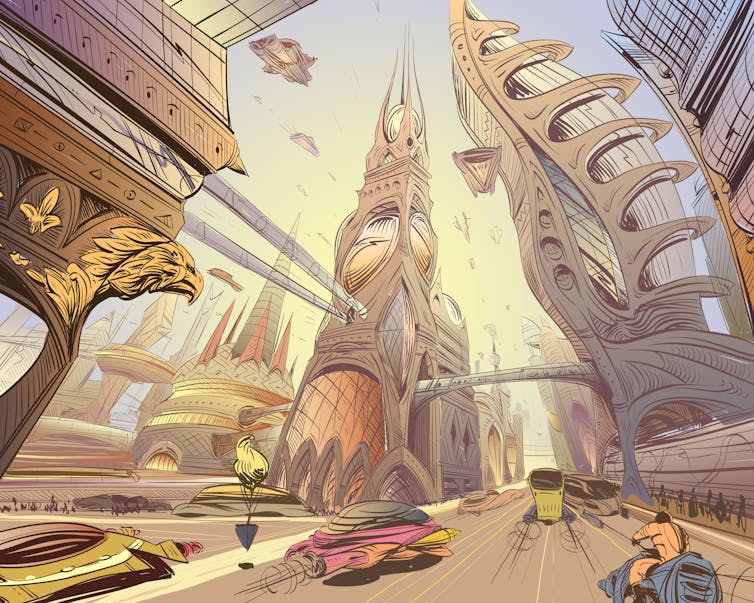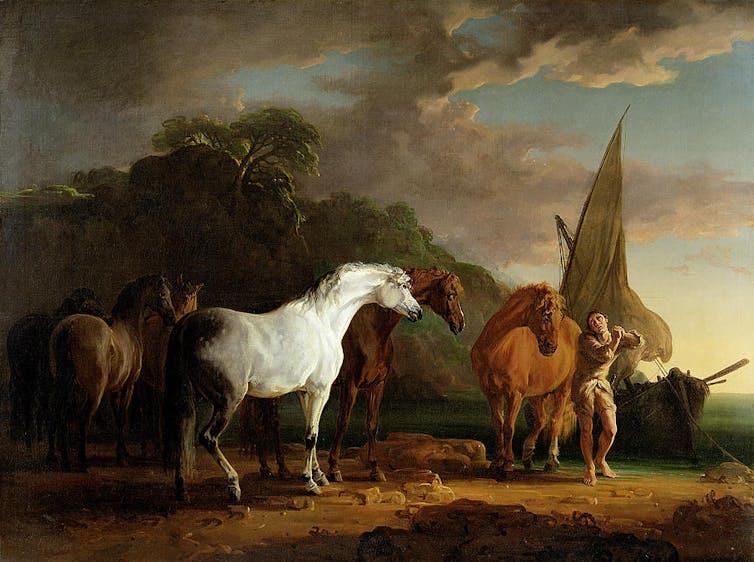Gandhi did not introduce the idea of the ideal state into political theory. The concept was first elaborated by the ancient Athenian philosopher Plato (427-347 B.C). His Republic evinces a desire to escape selfish, inelegant, and corrupt political relations, the dreadfulness of human nature, political competition that leads to instability, and complete degeneration of the finer aspects of society and the polity.
The philosopher constantly searches for a state that is so perfect, so balanced and so just that it is timeless. It is not of this earth. Plato’s Republic inspired later philosophers to conceive of a better society that can secure wellbeing and happiness or what Greeks called eudaimonia.
At the end of Section IX on Imperfect Societies in The Republic, participants in the conversation agree that such a society will not come into existence: “it is laid up as a pattern in heaven, where he who wishes can see it and found it in his own heart.
But it doesn’t matter whether it exists or ever will exist; in it alone and in no other society, could he take part in public affairs.” In effect, it is enough that we are motivated by the thought experiment to strive for a society that is far better than the one we live in.
The term ‘utopia’ was coined by Sir Thomas More (1478-1535) who lived out his life first as Lord Chancellor at the court, and then in the prisons of Henry the VIII (King of England from 1509-1547) till he was executed in 1535. He wrote Utopia in 1516. Sir Thomas More was a major figure of the Renaissance, poet, satirist, composer, author, and speaker.
He drew out the term utopia from the Greek ou-topos meaning a no-place, or ironically the opposite of topos or a good place. More was inspired by Plato, but unlike the Republic which engages in an abstract argument about justice, his work discussed in detail the social organisation and political arrangements of an ideal state.
True to the tradition of Plato’s utopia, More’s work showed a mirror to the English court mired as it was in sordid political intrigues and deadening conspiracies. In particular More was unhappy with the way Henry the VIII had renounced the Roman Catholic Church because the papacy had refused his plea to dissolve his first marriage to Catherine of Aragon.
The conflict between insitutionalised religion and the storm of reformism embraced by Henry the VIII heralded disaster for a man who was committed to Catholic orthodoxy. More’s refusal to accept the break with Rome and a new religion resulted in charges of treason. Expectedly he was executed.
In Utopia, More detailed an imaginary ideal community in which people share a common culture and way of life. At the core of More’s ideal society is the abolition of private property. Where he departs from Plato is his insistence on the primacy of manual work. Everyone should contribute their labour for the common good. Someone who does not work has to be punished. He, however, made an exception for scholars and officials; they need not work.
In More’s ideal state there will be no taverns, no alehouses, no brothels, no opportunities for seduction, and no secret meetings. Inhabitants must not only work but also spend their leisure time well, engage in conversation and attend public lectures. People can believe in God but no one should force his faith on others.
The literary critic Terry Eagleton wrote in the Guardian that the More’s Utopia is astonishingly radical stuff. “Not many lord chancellors of England have denounced private property, advocated a form of communism, and described the current social order as a ‘conspiracy of the rich’.” Yet More had watched with perfect composure heretics who were burnt at the stake when he was Chancellor.
Remarkably most utopian thinkers renounce city life and prefer small need-based rural communities. Whereas religious wars troubled More, for Leo Tolstoy writing in nineteenth century Russia, the Church had distorted the teachings of Christ. He was committed to creating an ideal society based on the teachings of Christ. His interpretation of the Sermon on the Mount influenced Gandhi.
Nineteenth century intellectuals in Russia were more than aware of the deeply flawed society they lived in, of an unjust society ruled by a hereditary monarch and one who allowed the peasants and an emerging working class to sink into the slough of misery and despondency. People had little access to education, employment was scarce, and ethnic minorities, the Jewish people and Poles were discriminated against.
Tolstoy believed that only if men could obey the principle of God enshrined in our heart, the state would wither away. The country would not need a standing army, and the people would not have to pay taxes to maintain it. In his diary on 13 January 1910, he wrote that he did not care whether his doctrines led to anarchism. In his ideal society, law courts based on violence and coercion would be irrelevant, and people have the right to judge and punish each other.
There will be equal distribution of private property and therefore no need for civil litigation. Inhabitants of Utopia will contribute labour to build roads and schools. People will pay taxes voluntarily for specific projects. Society will be sustained by subsistence agriculture. There would be no hierarchy between those who worked only by their brains and others by their muscles.
The only professionals he allowed were blacksmiths. Cities were irrelevant because they were built on the bodies of peasants. In his utopia, city folk will return to the land, take out their spades and begin to dig. This will enhance their capacity for intellectual work.
With a simplified economy there will be less need for money or factories, As for the railways, they appeared to him as the symbol of disaster as he had depicted in the opening sequence of ‘Anna Karenina’.
Common to all leading works on utopia, is the abolition of private property, the desirability of manual labour, simple living and elevated thinking, non-violence, abolition of class and exploitation, and in Tolstoy’s case the need to institutionalise the divine law. The impact of these formulations on Gandhi’s notion of swaraj is evident.
Gandhi’s ideal society in Hind Swaraj was the apogee of swaraj. For Gandhi, a life of simplicity and containment of one’s wants pre-empts struggles over power and resources. Thereby it contributes to social harmony.
Interestingly his commitment to spiritual swaraj or the realisation of the higher self, abolished not only the ego but also the overriding impulse to negotiate with other human beings howsoever different they may be to each other. Men in Gandhi’s ideal state are alarmingly alike, they had subdued their basic passions for higher ideals.
Once we do away with modern institutions and technology, selfishness disappears. So perfect is his ideal society, so conducive to the realisation of swaraj that man must be ready to sacrifice his life for the community.
His conception of the ideal society performed the function of all utopias, it showed a mirror to existing society and practices, it strove to attain a society that was far more desirable than the one that was in existence, and it facilitated swaraj or authentic freedom. The problems with Gandhi’s conceptualisation of utopia are best brought out by Nehru’s engagement with the concept.
Gandhi’s idealism that bordered on the bare life exasperated our quintessential modern- Nehru. Gandhi’s greatness or his services to India, said Nehru, were not in question. Yet the retreat to an agrarian society worried him. “All this seems to me utterly wrong and harmful doctrine and impossible of achievement. Behind it lies Gandhiji’s love and praise of poverty and suffering and the ascetic life…Personally I dislike the praise of poverty and suffering. I do not think they are at all desirable, and they ought to be abolished. Nor do I appreciate the ascetic life as a social ideal, though it may suit individuals. I understand and appreciate simplicity, equality, self-control, but not the mortification of the flesh,” Nehru had said.
“Nor do I”, he continued, “appreciate in the least the idealisation of the ‘simple peasant life’…instead of submitting to it myself I want to drag out even the peasantry from it, not to urbanisation, but to the spread of urban cultural facilities to rural areas.” “What”, asked Nehru in some perplexity “is there in the ‘Man with the Hoe’ to idealise over?”
He was also a little skeptical of Gandhi’s objective. “Gandhiji’s greatness or his services to India or the tremendous debt I personally owed to him were not in question” wrote Nehru. “But Gandhi, the supreme idealist, may be hopelessly in the wrong in many matters. In spite of my close association with him, wrote Nehru, I am not clear in my own mind about his objective, and I doubt If he is clear himself. Be good in your personal life and everything will follow. This is not a political or a scientific attitude and not perhaps even an ethical one. It is narrowly moralistic and begs the question-what is goodness?”
Nehru was also worried about Gandhi’s insistence on an abstract definition of swaraj that unfolded its many dimensions at different times. Gandhi believed that swaraj would evolve along with the freedom struggle, and he could be vague about its essential attributes. “Vagueness in an objective,” continued Nehru, “seems to me deplorable. Action to be effective must be directed towards clearly conceived ends. Life is not all logic and some ends will have to be varied from time to time, to fit in with it, but some ends must be clearly envisaged.”
Gandhi seems to know which direction he is going. But this does not fit in with modern conditions, for instance, his rejection of technological advances and his insistence that the rich live a peasant life.
Nehru’s predicament was acute. He loved Gandhi. All of us do, because there has not been such a man in India since the Buddha, so enlightened and so inspirational. He taught us tolerance and how to live together. He moved thousands of Indians to the core by his imagination, political inventiveness, creativity and sense of humour.
Yet we discern the same problem as Nehru did: “Gandhiji is always thinking in terms of personal salvation and of sin, while most of us have society’s welfare uppermost in our minds…He is not out to change society or the social structure, he devotes himself to the eradication of sin from individuals. It is not society but individuals who had to change.”
Nehru’s unease with Gandhian ideas can be appreciated only when we understand that society must be socially, culturally and economically transformed through collective action. We cannot rely on individual transformation to achieve this task.
Individual have different temperaments some are benevolent, others selfish, some believe in sharing, others on acquisition, some are religious, some cosmopolitan and others atheists. Their interests differ, their mentalities are diverse, their motivations are different, and above all colonialism had sparked off the spirit of competitive nationalism by its policies of segmented representation.
Gandhi did not take into account the lesson of political pragmatism evinced by the idealist Jean Jacques Rousseau who had memorably said that we must take men as they are and laws as they should be. Gandhi did not take men as they are, they had to achieve individual perfection to be genuinely free of ego and of the acquisitive instinct. He miscalculated. It was precisely the display of competitiveness and acquisition that shook him as independence came near.
On 5 June 1947 he wrote: ‘it is very difficult-practically impossible- to achieve real swaraj without self-denial…But today we are engaged in a race for positions of power. Shall I describe it as my own tragedy, the tragedy of our soldiers of truth and ahimsa?”
Competitive nationalism reached an apogee during the Partition. And he wrote to an associate on 25 July 1947: ‘Why so jubilant? Purna swaraj is far off. Have we got swaraj? Did swaraj mean only that the British rule should end? To my mind it was not so. For me Sabarmati is far off Noakhali is near.”
Finally, Gandhi, like other utopians did not make room for politics as contestation in his ideal state. Where is the plurality of social groups, of diverse opinions, of different practices, and of distinct dispositions in Gandhi’s village republic?
In Gandhi’s swaraj people might erode their ego, conquer their passions, realise their spiritual selves, but will they learn how to get along with others, accept that they are different, and stand with them in shimmering moments of solidarity?
Politics as contestation leads to politics as cooperation only through solidarity and acceptance of diversity. Utopias are so perfect that they rule out both contestation and solidarity. Above all utopias suppress plurality, and politics as the negotiation of plurality. They try to get away from the messiness of politics and land up as apolitical.
Neera Chandhoke was a professor of political science at Delhi University.



















